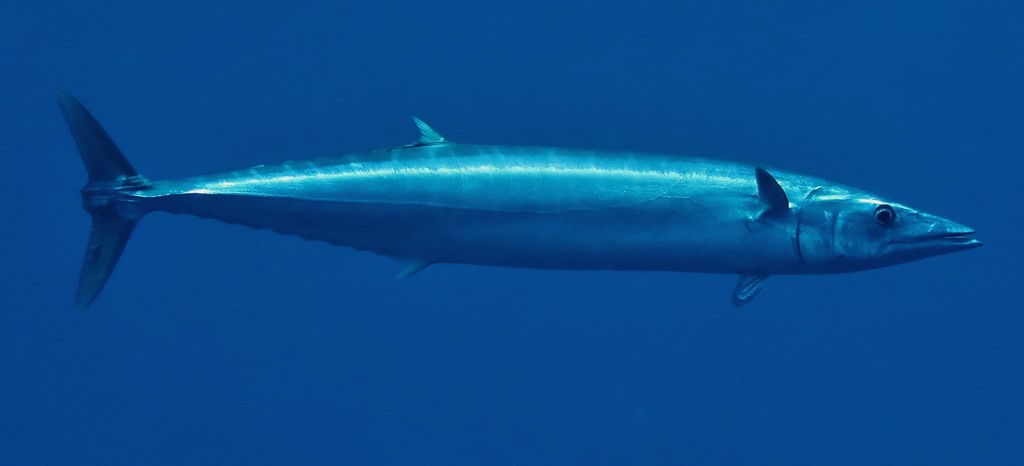ACANTHOCYBIUM SOLANDRI - (CUVIER, 1832)
Picture courtesy of: Alain Daoulas
Actinopterygii (Gigaclass) > Actinopteri (Class) > Teleostei (Subclass) > Scombriformes (Order) > Scombroidei (Suborder) > Scombridae (Family) > Scombrinae (Subfamily) > Acanthocybium (Genus)
Thazar noir, Wahoo, Bastard mackerel, Jack mackerel, Mongrel mackerel, Pike mackerel, Wahoo fish, Kamasu-sawara, カマスサワラ, 꼬치삼치, 棘鰆, 沙氏刺鮁,
Synonymes
Acanthocybium forbesi (Seale, 1912)
Acanthocybium petus (Poey, 1860)
Acanthocybium sara (Lay & Bennett, 1839)
Acanthocybium solanderi (Cuvier, 1832)
Acanthocybrium solandri (Cuvier, 1832)
Acanthoscybium solanderi (Cuvier, 1832)
Acantocybium solandri (Cuvier, 1832)
Cybium petus (Poey, 1860)
Cybium sara (Lay & Bennett, 1839)
Cybium solandri (Cuvier, 1832)
Cybium verany (Döderlein, 1872)
Scomber amarui (Curtiss, 1938)
-----------------------------
Description
Dorsal spines (total): 23-27; Dorsal soft rays (total): 12-16 + 8-9 finlets; Anal soft rays: 12-14 + 9 finlets; Vertebrae: 62-64. Mouth large with strong, triangular, compressed and finely serrate teeth. Gill rakers absent; Snout about as long as the rest of head. Posterior part of maxilla completely concealed under preorbital bone. Interpelvic process small and bifid. Swim bladder present. Body covered with small scales. No anterior corselet developed. A single lateral line curves downward under the first dorsal fin. Caudal peduncle slender with one large lateral keel, flanked by a smaller keel on each side. Max. length: 250 cm TL, common length: 170 cm FL. Max. published weight: 83.0 kg. Depth range: 0 - 200 m, usually: 0 - 12 m.
Color
An iridescent bluish-green mackerel with silvery sides, 24-30 cobalt blue blue vertical bars extending below the lateral line that rapidly fade after death, and a white underside.
Etymology
Acanthocybium: from ancient Greek, ákanthos = thorn, spine + from ancient Greek, kúbion = a tunny fish or a dish made of pieces of the tunny fish salted and chopped. Referring to spines on first dorsal fin (23-27).
solandri: in honor of Swedish naturalist Daniel Solander (1733-1782), whose notes and illustration provided the descriptive material for Cuvier.
Original description: Cybium solandri Cuvier, 1832 - Type locality: no locality stated. No types known.
Distribution
Circumglobal in tropical and warm temperate seas (including Caribbean Sea, Mediterranean Sea, Persian Gulf, Sea of Japan) and New Caledonia.
Biology
An oceanic, epipelagic species frequently solitary or forming small loose aggregations rather than compact schools. Feed on fishes and squids. Eggs and larvae are pelagic. An important sport fish in some areas. Marketed fresh, salted or spice-cured slices of meat; also frozen. Flesh of very good quality. Spawning seems to extend over a long period; Fish in different maturity stages are frequently caught at the same time. They are one of the fastest fish in the ocean, swimming at up to 80 km/hr.
Similar species
Scomberomorus commerson (Lacepède, 1800) - Reported from New Caledonia - Link to the species (here).
Last update: 22, March 2022
Actinopterygii (Gigaclass) > Actinopteri (Class) > Teleostei (Subclass) > Scombriformes (Order) > Scombroidei (Suborder) > Scombridae (Family) > Scombrinae (Subfamily) > Acanthocybium (Genus)
Thazar noir, Wahoo, Bastard mackerel, Jack mackerel, Mongrel mackerel, Pike mackerel, Wahoo fish, Kamasu-sawara, カマスサワラ, 꼬치삼치, 棘鰆, 沙氏刺鮁,
Synonymes
Acanthocybium forbesi (Seale, 1912)
Acanthocybium petus (Poey, 1860)
Acanthocybium sara (Lay & Bennett, 1839)
Acanthocybium solanderi (Cuvier, 1832)
Acanthocybrium solandri (Cuvier, 1832)
Acanthoscybium solanderi (Cuvier, 1832)
Acantocybium solandri (Cuvier, 1832)
Cybium petus (Poey, 1860)
Cybium sara (Lay & Bennett, 1839)
Cybium solandri (Cuvier, 1832)
Cybium verany (Döderlein, 1872)
Scomber amarui (Curtiss, 1938)
-----------------------------
Description
Dorsal spines (total): 23-27; Dorsal soft rays (total): 12-16 + 8-9 finlets; Anal soft rays: 12-14 + 9 finlets; Vertebrae: 62-64. Mouth large with strong, triangular, compressed and finely serrate teeth. Gill rakers absent; Snout about as long as the rest of head. Posterior part of maxilla completely concealed under preorbital bone. Interpelvic process small and bifid. Swim bladder present. Body covered with small scales. No anterior corselet developed. A single lateral line curves downward under the first dorsal fin. Caudal peduncle slender with one large lateral keel, flanked by a smaller keel on each side. Max. length: 250 cm TL, common length: 170 cm FL. Max. published weight: 83.0 kg. Depth range: 0 - 200 m, usually: 0 - 12 m.
Color
An iridescent bluish-green mackerel with silvery sides, 24-30 cobalt blue blue vertical bars extending below the lateral line that rapidly fade after death, and a white underside.
Etymology
Acanthocybium: from ancient Greek, ákanthos = thorn, spine + from ancient Greek, kúbion = a tunny fish or a dish made of pieces of the tunny fish salted and chopped. Referring to spines on first dorsal fin (23-27).
solandri: in honor of Swedish naturalist Daniel Solander (1733-1782), whose notes and illustration provided the descriptive material for Cuvier.
Original description: Cybium solandri Cuvier, 1832 - Type locality: no locality stated. No types known.
Distribution
Circumglobal in tropical and warm temperate seas (including Caribbean Sea, Mediterranean Sea, Persian Gulf, Sea of Japan) and New Caledonia.
Biology
An oceanic, epipelagic species frequently solitary or forming small loose aggregations rather than compact schools. Feed on fishes and squids. Eggs and larvae are pelagic. An important sport fish in some areas. Marketed fresh, salted or spice-cured slices of meat; also frozen. Flesh of very good quality. Spawning seems to extend over a long period; Fish in different maturity stages are frequently caught at the same time. They are one of the fastest fish in the ocean, swimming at up to 80 km/hr.
Similar species
Scomberomorus commerson (Lacepède, 1800) - Reported from New Caledonia - Link to the species (here).
Last update: 22, March 2022
